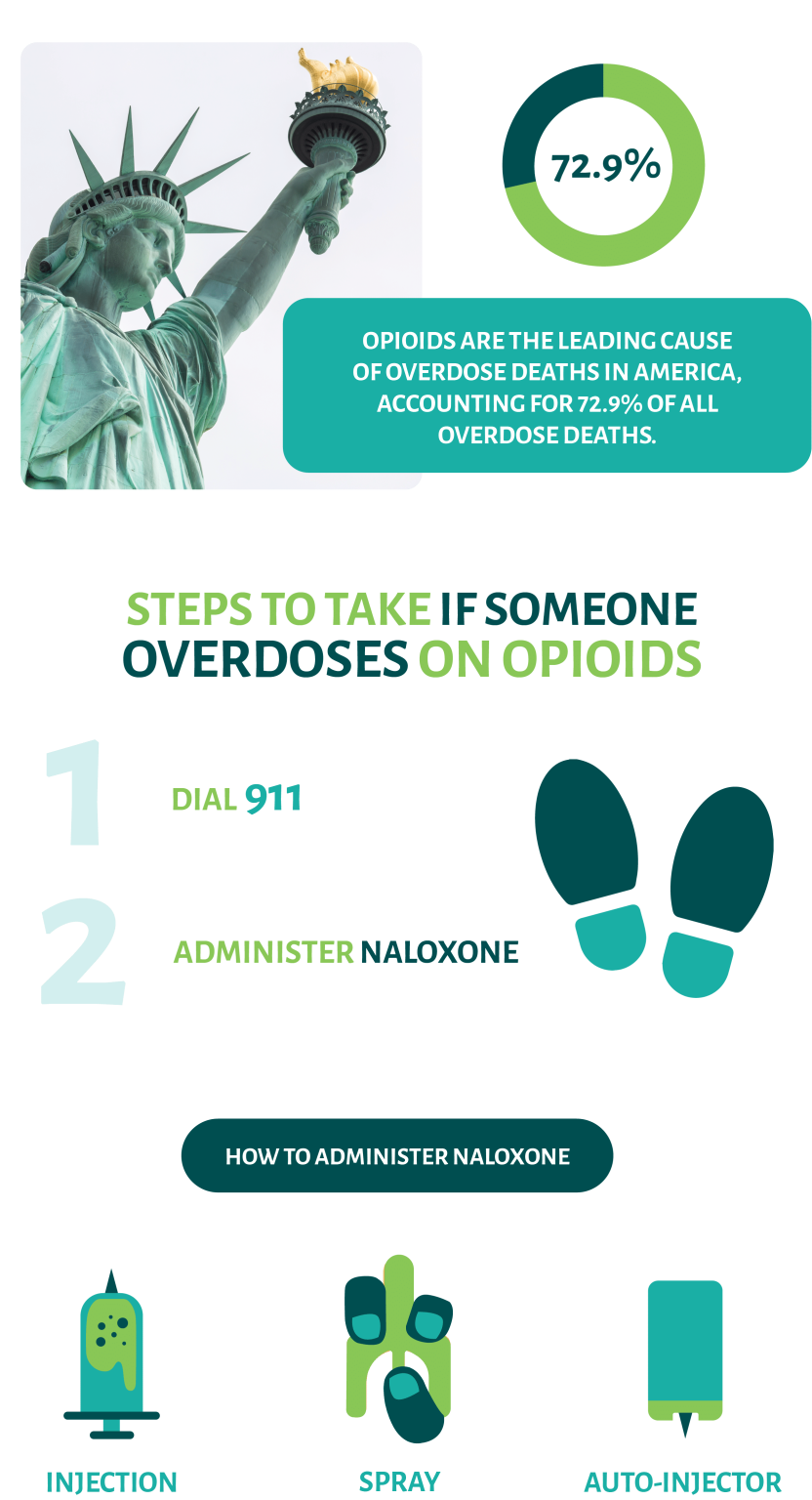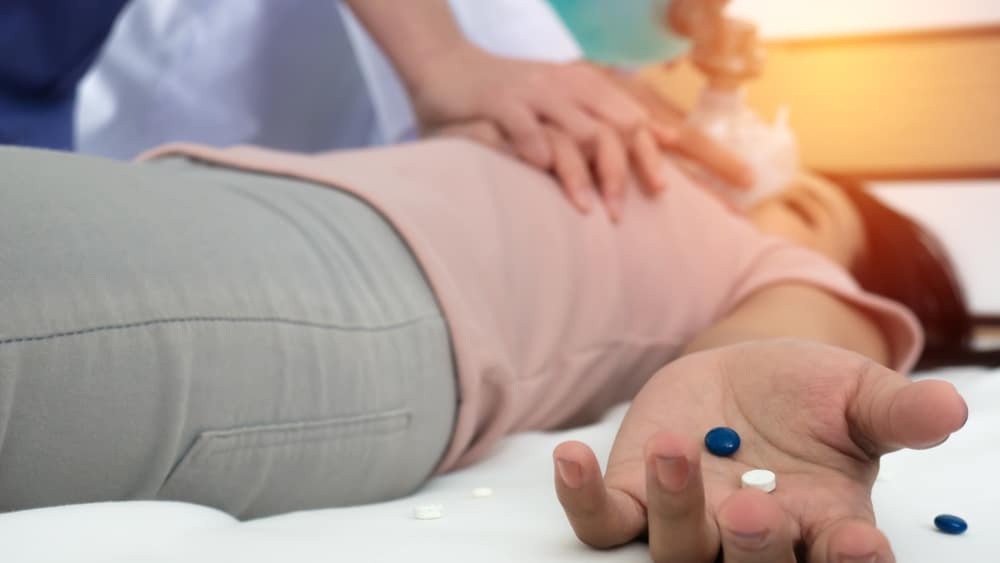Narcan is an opioid overdose reversal drug. Naloxone is the generic, active ingredient in Narcan. Naloxone is a medication that quickly reverses the effects of an opioid overdose. People can also use Narcan on patients after surgery to reverse the effects of opiates. Naloxone is even given to newborn babies to decrease the effects of any opiates that they may have received from their mothers. Now that you know what it is, you should learn how long Narcan lasts.
How Long Does Narcan Last?
The answer to the question, how long does Narcan last is anywhere from 30 to 90 minutes. To further understand how long the effects of Narcan can last, it’s crucial to understand how Naloxone works and what needs to happen if someone overdoses on opioids. This is because the effects of opioids typically last longer than Narcan. Therefore, individuals that overdose on opioids may need to repeat their dosage of Narcan as a form of opioid overdose treatment.
Also, if people use opioids while Naloxone is in their systems, they’ll probably not feel the effects of the opioids. As a result, such people may take more opioids. Then, once the Narcan wears off, they will be more likely to overdose.
What Does Narcan Work On?
Narcan is classified as an opioid antagonist. This means that it binds to opioid receptors and blocks the effects of opioid drugs that someone may have taken. If a person overdoses on opioids, like pain relievers or illicit substances – like heroin – Narcan can return that person’s breathing patterns to normal.
Narcan will not work on any other type of drug overdoses like alcohol, cocaine, or benzodiazepines. Narcan only treats opioid overdoses. It’s also important to note that a person cannot get a “high” from Narcan.
What are Opioids?
Opioids are a class of drugs that bind to certain receptor sites located throughout the body and central nervous system. When someone takes opioids, it slows down the essential functions of that person’s body and changes how that person perceives pain. As a result, Narcan’s use has become an integral part of harm reduction strategies in many places in the U.S.
Breathing is one of the essential functions slowed by opioids. When someone takes a dose of opioids that’s more than that person’s brain and body can handle, his or her breathing can slow to a dangerous or deadly level. That is an opioid overdose.
The signs of an opioid overdose include:
- Tiny, pinpoint pupils
- Slack or droopy muscles
- Nodding off
- Loss of consciousness
- Nonresponsive to stimuli
- Not able to talk, even if awake
- Slow or shallow breathing
- Skin with a purplish, gray, or ashen color
- Choking or snoring sounds
- Vomiting
- Slow, erratic, or stopped pulse
- Fingernails and lips may turn purple or blue
How is Naloxone Given?
Naloxone is given in one of three FDA-approved forms, through an intramuscular injectable, through an intranasal, and intravenously.
Injectable/Intravenous Narcan
The injectable form of naloxone should only be given by professionals trained in its use. Emergency kits used by first responders often include injectable naloxone. The auto-injectable naloxone product is delivered into the outer thigh. The product provides verbal instructions when activated, letting the person administering the medication know what to do when using it.
There is a brand-name auto-injectable Naloxone product called EVZIO, which can be used by emergency responders and family members or loved ones of someone who is overdosing. This form of Narcan is also used in a medical setting intravenously for surgeries.
Nasal Spray Narcan
The most commonly used type of Narcan comes in the form of a nasal spray that is pre-filled and assembled and doesn’t require the use of needles. People experiencing opioid overdoses would receive the Narcan nasal spray in their nostrils while they’re on their backs. Narcan nasal spray was also designed for family, friends, and caregivers that have no medical training to be able to use.
People can purchase Narcan nasal spray at any pharmacy without a doctor’s prescription. Under a statewide order, in every state, residents can purchase Narcan nasal spray from a local pharmacist. This drug is an important tool in the fight against opioid abuse and overdoses.

Who Can Give Naloxone if Someone Overdoses on Opioids?
The liquid form for the injection or intravenous use of Narcan is primarily used by paramedics, specially trained first responders, and emergency room doctors. The Narcan nasal spray is the easiest form of Naloxone to use. Thus, anyone can give it if they see an opioid overdose happening.
Major pharmacy chains, including Walgreens and CVS, now provide naloxone without a prescription in all U.S. stores. This makes it much easier for friends and family of loved ones that may be suffering from opioid use disorders to gain access to naloxone.
According to the CDC, fentanyl-laced opioids have contributed to 80% of opioid overdose deaths in the 12 months leading up to November 2020. Opioid overdoses comprised roughly three-quarters of all overdose deaths in 2020. Also, an estimated 128 people die every day because of opioid overdoses. Being prepared for opioid overdoses by having Narcan on hand can make help a world of difference in the number of opioid overdose deaths.
How Long Does Narcan Take to Work?
Once administered, naloxone usually starts taking effect within two to three minutes. If the person receiving Narcan doesn’t wake up within 3 minutes of being administered the drug, that person should immediately be given another dose. Rescue breathing should be done as Narcan is given so that the person suffering from the opioid overdose is getting critical oxygen to his or her brain.
Amid the ongoing opioid epidemic, all individuals need to have a broad-based understanding of how Narcan works because it can be lifesaving. Individuals can talk to their pharmacists about obtaining Narcan overdose kits.
Once Administered, How Long Does Narcan Last?
Narcan or naloxone typically wears off in 30 to 90 minutes. Thus, it’s possible that someone given Narcan can stop breathing unless he or she receives more naloxone. That is why no matter what, it’s critical to contact 911 if someone is experiencing an opioid overdose.
While Narcan is a vital drug to help save someone’s life from an opioid overdose, emergency medical attention is still needed if someone is overdosing on opioids. Keep in mind though that because of how long Naracan lasts, individuals that suffer from opioid overdoses should be monitored for another 2 hours after the last dose of the substance is given.
Are There Any Risks of Narcan?
Overall, naloxone and Narcan have few, if any, risks. This is because Narcan isn’t considered a controlled substance and therefore, has no abuse or addiction potential. This means that Narcan has no street value and individuals can’t get addicted to Narcan.
Narcan has few side effects. Some people may find though that Narcan causes them to experience allergic reactions. People shouldn’t administer Narcan to women who are nursing or pregnant unless they are clearly overdosing from opioids. Once a person administers Narcan to someone with a physical dependence on opioids, the person receiving the Narcan will experience withdrawal symptoms. These are pretty uncomfortable, but not life-threatening.
Opioids Effects and Abuse
Opioids are powerful and highly addictive drugs. Prescription opioids include oxycodone, hydrocodone, morphine, and methadone. Heroin is an illegal opioid. Still, heroin usage has increased in the U.S. across nearly all demographics.
Fentanyl is an incredibly powerful synthetic opioid. People make illicit fentanyl and sell it on the black market. This causes fentanyl users to frequently experience overdoses and deaths, even when using a small amount of the drug.
Luckily, over the past couple of years, opioid overdose deaths have declined slightly. The opioid epidemic remains pervasive though, thus causing a deadly issue in the United States.
Opioid Addiction Treatment
Opioid addiction treatment is an important way to reclaim control of one’s life. If you’ve experienced an opioid overdose and require the use of Narcan, it may be more motivating for you to seek professional treatment and get help. Opioid addiction treatment can be done on an inpatient or outpatient basis.
Many people will participate in several steps of care.
For example, someone might initially start treatment in an intensive inpatient program and eventually move into a lower level of care – such as one of the many outpatient treatment programs. During an opioid addiction treatment program, the physical effects need to be considered first.
As you go through opioid withdrawal, you may find that you’re experiencing serious symptoms that require medical supervision and care. Following detox, people that suffer from opioid addiction can begin their recovery programs. Opioid addiction recovery programs address people’s underlying opioid use issues. Addiction treatment plans for opioids should be tailored, personalized experiences because every individual is unique and has his or her own specific needs.
Paying for Opioid Addiction Treatment
Too often, people are fearful that they can’t afford rehab. The reality is that insurance often covers some or all of addiction treatment. Thus, North Jersey Recovery Center’s team works with your insurance company to verify what your plan covers.
We provide free insurance verification to determine what financial options are available to help each patient pay for opioid addiction treatment. If you don’t have insurance, there are still flexible opioid treatment payment options that you can take advantage of.
The most crucial thing is the opioid addiction treatment itself. This is because opioid addiction treatment helps people overcome their opioid dependence and addictions. That way individuals that suffer from opioid addictions can regain control over their lives.
Final Thoughts: How Long Does Narcan Last?
The answer to the question, how long does Narcan last, could be an indicator you’re struggling with opioid use. Narcan is a brand name of naloxone that lasts 30 to 90 minutes. While it can help reverse an opioid overdose, what Naloxone doesn’t do is serve as a treatment for opioid addiction.
Opioid addiction often requires a professional level of treatment, such as the programs available here at North Jersey Recovery Center (NJRC). Our team here at NJRC will develop an opioid addiction treatment and recovery plan that works best for you. That means that you don’t have to struggle with opioid use disorder any longer. We encourage you to reach out to our admissions team here at NJRC to learn more about opioid addiction today.
Reviewed for Medical & Clinical Accuracy by Laura Riley








